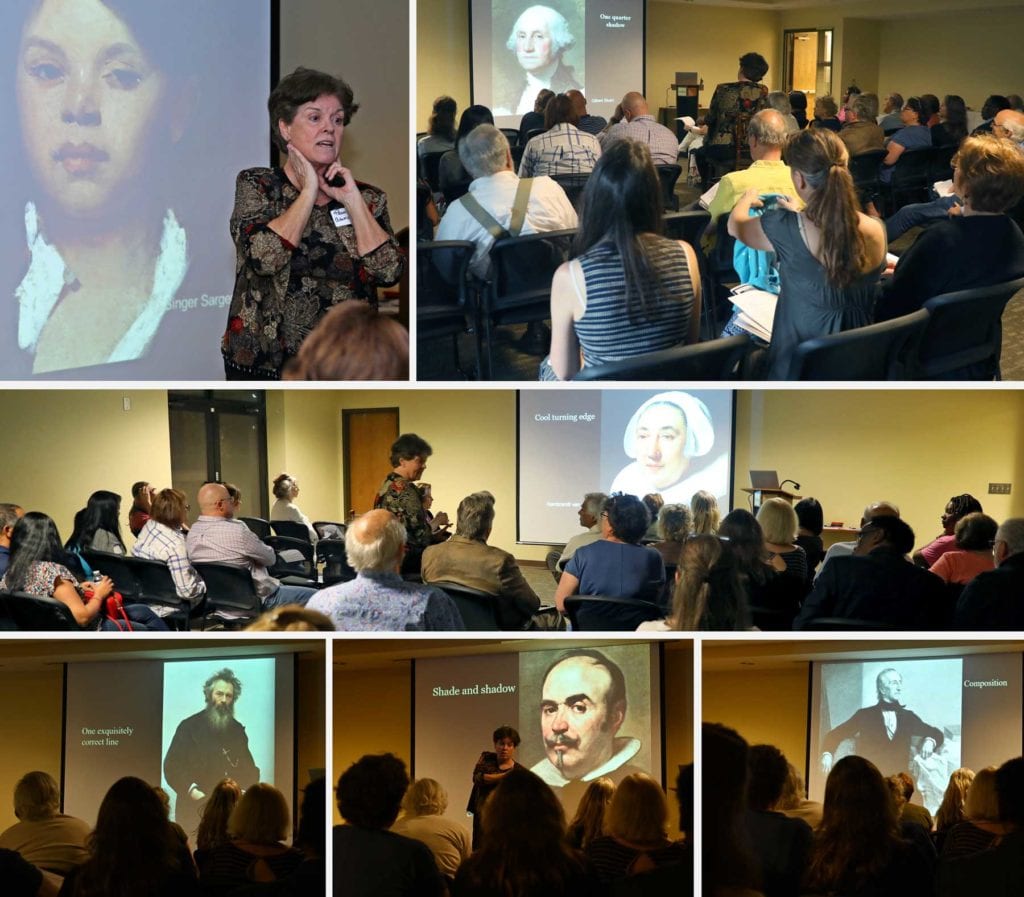By Rebecca Kemmerer
 Margaret (Peggy) Carter Baumgaertner shared her approach to portrait painting in an excellent presentation at the Portrait Society of Atlanta’s April meeting, illustrating her presentation with examples from Van Dyck and Rembrandt to Sargent and Cassatt to her own work. She outlined five things that are required for a good portrait:
Margaret (Peggy) Carter Baumgaertner shared her approach to portrait painting in an excellent presentation at the Portrait Society of Atlanta’s April meeting, illustrating her presentation with examples from Van Dyck and Rembrandt to Sargent and Cassatt to her own work. She outlined five things that are required for a good portrait:
• Precise drawing: a correct silhouette shape, attention to detail and accuracy. Shapes should be defined by a perfectly drawn single line.
• Light and shadow: it is either in light or in shadow; there are no half-tones. She noted that if a painting is outside on an overcast day, it’s all in shadow. “Mirroring” is useful if you can’t see the shadow shape; that is, mirror the shape of the face on the side you are able to see. She noted that the shadow will be complementary in color and temperature to the lighted side. She likes to paint in warm light, resulting in cool shadows. Portraits are generally painted with three kinds of lighting: full light, one-quarter light, or half-shadow. The shadow shapes will be the same in each case.
• Three-value massing: In your painting, mass shapes in three values only, and do not cross values within each mass. Your composition is created by this three-value massing. Within each value, there can be gradations. It’s helpful to use black and white images to see values better. Lost and found edges are defined by the values: two adjacent masses of the same value create a lost edge; different adjacent values create a hard edge.
• The head is a rounded egg. The shadow shapes and the lighted shapes are flat. Three kinds of shadows on the head are the cast shadow, the cool turning edge and the terminator edge. The terminator edge is where the light meets the shadow. That area is darker than the light, yet it belongs to the light, not the shadow. The cool turning edge is on the lighted side, on the edge of the head and face. The form should be turned only on the terminator and cool turning edges, not within the light. Baumgaertner differentiated between shade and shadow: shade is in the light where the light is hitting at an angle, while in shadow there is no direct light.
• Placing the features: the features are placed after the head is developed based on the skull. Once the eye sockets are in, defined in part by the “bird wings” or eyebrow/shadows, the eyes are dropped in “like poached eggs.” The muzzle is created, then the “mush mouth” is (sometimes) added, which can be little more than a line for the middle.
Other useful tips: paint from life, find and use natural poses, and work at an appropriate scale. A small child is best painted looking down at the subject, while a formal corporate portrait may be slightly larger than life. To help negate the distortion found in photography, take a series of reference photos following the way the eye sees: first the head, then progressing down the body, as the camera will distort the scale away from the focal point. Think about the characteristics of the person you want to portray in the portrait.
Even though a wide variety of styles, eras, and subjects were presented, the remarkable slide show of master portraits from over a 500-year span all followed the concepts discussed by Margaret Baumgaertner. The audience was entertained and enlightened by this simple yet comprehensive way to approach understanding portraiture.
To read more about Margaret Carter Baumgaertner, click here.
Photo credit: Vinod Sharma


